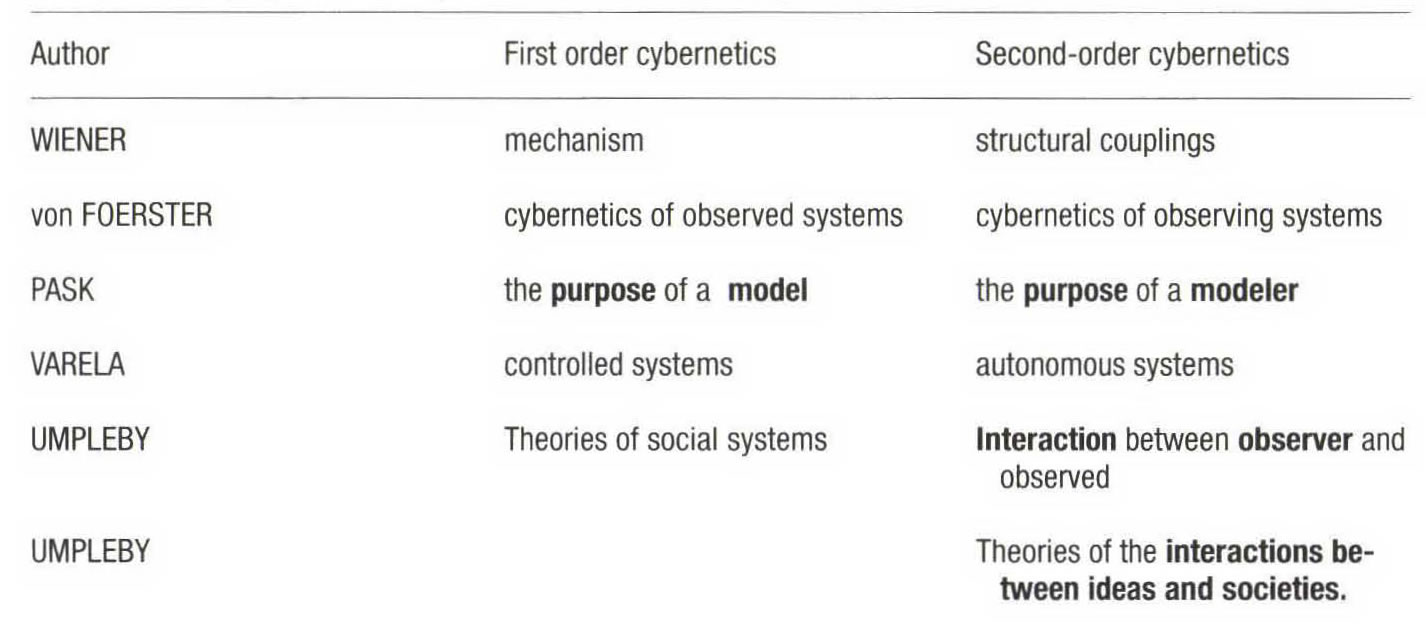CYBERNETICS (First and Second Order) 1)
← Back
Stuart UMPLEBY explains as follows the differences between Cybernetics of the 1st and 2nd order.
"Cyberneticians have distinguished the recent work in cybernetics on constructivist epistemologies from the earlier work on control systems by using the term "second-order cybernetics". This term was first used by Heinz VON FOERSTER, who defined first-order cybernetics as the cybernetics of observed systems, whereas second-order cybernetics is the cybernetics of the observing systems (von FOERSTER, 1979). von FOERSTER intends the term "observing systems" to be interpreted in two ways: either systems that observe or the act of observing systems. Gordon PASK made a similar distinction when he defined first-order cybernetics as dealing with the purpose of a model, whereas second-order cybernetics deals with the purpose of the modeler. Francisco VARELA suggested that first-order cybernetics is concerned with controlled systems, whereas second-order cybernetics is concerned with autonomous systems" (1990, p.112).
S. BRIER enounces as follows the program of 2 order cybernetics: "The basic concepts developed… are autopoiesis, closedness, Eigen-values and the idea that the production of information is internal to the autopoietic system, and that perception and communication are based on structural couplings"(1995, p. 6)
Closedness should be understood as organizational closure obtained through recursivity
S. UMPLEBY proposed "two additional conceptions of second-order cybernetics (1979). First-order cybernetics can be said to be concerned with interactions among the variables in a system, whereas second-order cybemetics is concerned with the interaction between the observer and the observed. The final definition goes beyond the one-brain problem of psychology or artificial intelligence and focuses instead on the n-brain problem of communities or societies" (p.112).
The following table gives a summary of UMPLEBY's views:
TABLE 1. Definitions of First- and Second- Order Cybernetics (p.113)

Categories
- 1) General information
- 2) Methodology or model
- 3) Epistemology, ontology and semantics
- 4) Human sciences
- 5) Discipline oriented
Publisher
Bertalanffy Center for the Study of Systems Science(2020).
To cite this page, please use the following information:
Bertalanffy Center for the Study of Systems Science (2020). Title of the entry. In Charles François (Ed.), International Encyclopedia of Systems and Cybernetics (2). Retrieved from www.systemspedia.org/[full/url]
We thank the following partners for making the open access of this volume possible:

